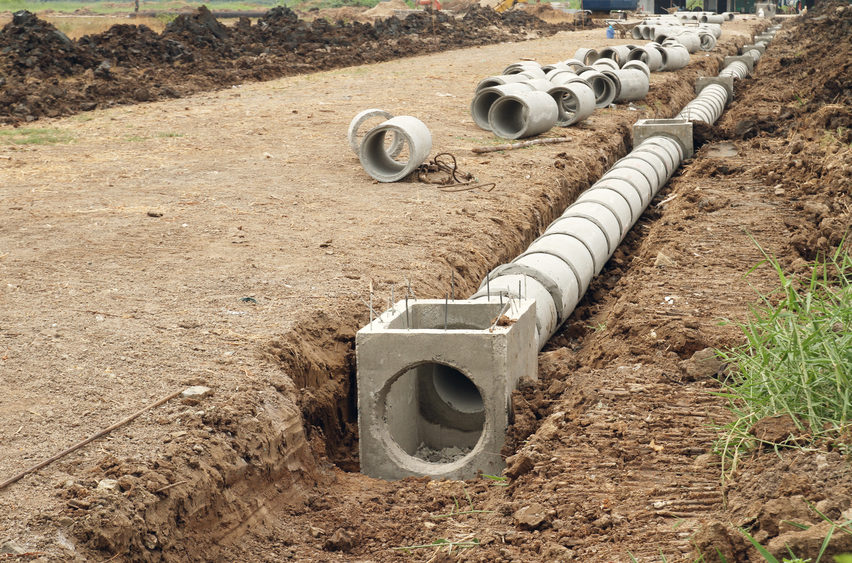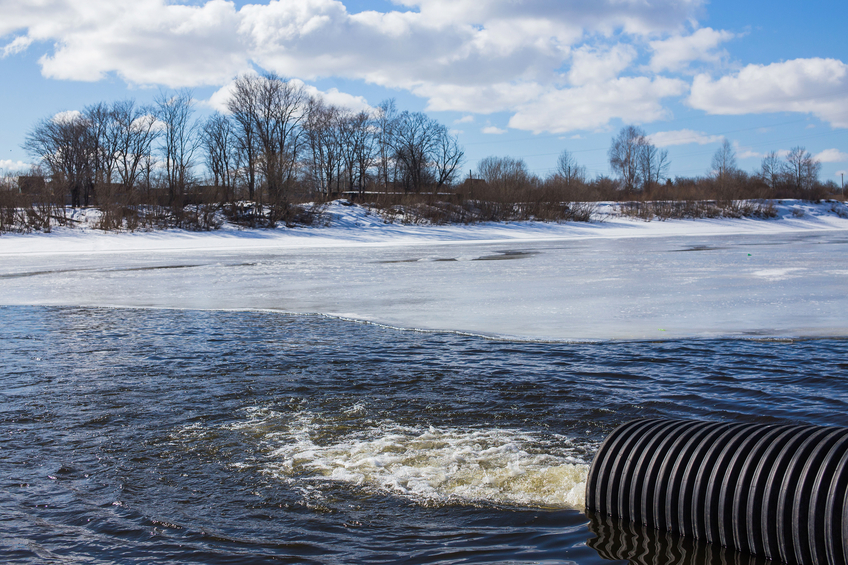Ohio Stormwater and Ethics 30 PDH Discount Package 3
Post Construction Storm Water Management - Non Structural BMP's (C06-001)
Stormwater Best Management Practice Design: Vegetative Biofilters (C10-003)
Stormwater Calculator: Guide and Application (C04-073)
Storm Water Pollution Prevention Plans for NPDES Construction Sites (C05-009)
General Principles of Engineering Ethics (LE2-016)

This online engineering PDH course provides an introduction to stormwater drainage systems and improvements for land development projects, as well as design strategies and considerations in site development.
Stormwater drainage systems include surface drainage systems, underground drainage systems, stormwater management facilities, and erosion and sediment control systems. The design of the stormwater drainage system and management addresses several elements including stormwater management plan, temporary and permanent erosion and sediment control practices, site grading, utilization of overland flow and natural site features, as well as the construction of culverts, ditches, and other drainage structures.
This 3 PDH online course is intended for civil engineers and other design and construction professionals seeking an introduction to stormwater drainage and site development strategies.
This PE continuing education course is intended to provide you with the following specific knowledge and skills:
-
Learning about approaches to stormwater roof drainage
-
Learning how to manage surface storm drainage systems
-
Understanding the fundamental features and structures for underground storm drainage systems
-
Understanding the fundamentals management of site drainage systems
-
Knowing the design principles for pump stations
-
Learning about safety considerations relative to stormwater drainage
-
Learning about security issues with drainage systems
-
Learning about generator leads and switch yards
-
Learning about special considerations for runways and taxiways for airfield drainage
-
Knowing how to approach site development projects comprehensively
In this professional engineering CEU course, you need to review the course document titled, "An Introduction to Stormwater Drainage and Site Development".
Upon successful completion of the quiz, print your Certificate of Completion instantly. (Note: if you are paying by check or money order, you will be able to print it after we receive your payment.) For your convenience, we will also email it to you. Please note that you can log in to your account at any time to access and print your Certificate of Completion.

This online engineering PDH course addresses the implementation of non-structural best management practices for post construction storm water management.
Erosion and sedimentation related to construction site storm water runoff can significantly affect the aquatic population and hydraulic characteristics of the receiving waters. Alterations in hydraulic characteristics of streams receiving runoff include higher peak flow rates, increased frequency and duration of bankfull and subbankfull flows, increased occurrences of downstream flooding, and reduced baseflow levels.
EPA recognizes that such alterations can be prevented by implementing an effective storm water management program. Therefore the EPA published the Storm Water Phase II Rule on
This 6 PDH online course is applicable to municipality owner and/or operators, construction contractors/workers, site developers, engineers, managers, and all other personnel involved in the implementation of non-structural best management practices for post construction storm water management.
This PE continuing education course is intended to provide you with the following specific knowledge and skills:
- Types and methods of non- structural bmp for storm water management
- Applicability
- Siting and design criteria
- Maintenance and cost considerations
- Effectiveness and limitations
In this professional engineering CEU course, you need to review EPA’s “Non-Structural BMP” section of the “Post Construction Storm Water Management in New Development and Redevelopment”. This section of the BMP addresses the following:
- Alum Injection
- On-Lot Treatment
- Buffer Zones
- Open Space Design
- Urban Forestry
- Conservation Easements
- Infrastructure Planning
- Narrower Residential Streets
- Eliminating Curbs and Gutters
- Green Parking
- Alternative Turnarounds
- Alternative Pavers
- BMP Inspection and Maintenance
- Ordinances for Post Construction Runoff
- Zoning
Once you complete your course review, you need to take a multiple-choice quiz consisting of thirty (30) questions to earn 6 PDH credits. The quiz will be based on this EPA publication.
Upon successful completion of the quiz, print your Certificate of Completion instantly. (Note: if you are paying by check or money order, you will be able to print it after we receive your payment.) For your convenience, we will also email it to you. Please note that you can log in to your account at any time to access and print your Certificate of Completion.

This online engineering PDH course provides design guidance for BMPs referred to as vegetative biofilters. Three different types of these on-site BMPs are described in this course and include grass swales, vegetated filter strips and bioretention cells.
The goals and objectives of best management practice (BMP) for stormwater management are as diverse as the situations to which they are applied.
This 10 PDH online course is applicable to civil and geotechnical engineers, site developers, and contractors as well as design and construction personnel involved with the planning and design of stormwater systems.
This PE continuing education course is intended to provide you with the following specific knowledge and skills:
- Overview of grass swales, vegetated filter strips and bioretention cells
- Review general design considerations associated with vegetative biofilters
- Analytical procedures for runoff volumes and rates, and sediment and nutrient loading (runoff and loading calculation examples included)
- Factors affecting vegetative filter strips
- Design guidance and procedures for vegetative filter strips
- Grass swale design guidance and considerations
- Guidance on bioretention cells
In this professional engineering CEU course, you need to review Sections 1 through 7 of the US Environmental Protection Agency (EPA) Publication EPA/600/R-04/121A, "Stormwater Best Management Practice Design Guide: Volume 2 Vegetative Biofilters".
Upon successful completion of the quiz, print your Certificate of Completion instantly. (Note: if you are paying by check or money order, you will be able to print it after we receive your payment.) For your convenience, we will also email it to you. Please note that you can log in to your account at any time to access and print your Certificate of Completion.

This online engineering PDH course offers a comprehensive introduction to managing stormwater, which is crucial for sustainable site development and flood prevention.
This course explores the National Stormwater Calculator (SWC), a powerful web-based tool created by the U.S. Environmental Protection Agency (EPA). It offers a step-by-step guide on how to effectively use the SWC to estimate runoff, retention, and low-impact development (LID) performance for any location across the United States.
In addition, this course focuses on assessing hydrological conditions, incorporating climate projections, and applying LID controls to improve site resilience. It equips professionals such as engineers, planners, and property developers with the tools and strategies needed to make informed, data-driven decisions and enhance the sustainability of their stormwater management projects.
This 4 PDH online course is applicable to civil engineers, environmental consultants, as well as other technical professionals who are engaged in stormwater management, site development, and green infrastructure planning.
This PE continuing education course is intended to provide you with the following specific knowledge and skills:
- Understanding the essential features and uses of the National Stormwater Calculator
- Learning how to enter site-specific data for accurate runoff estimations
- Knowing the effects of land cover, soil type, and drainage on stormwater dynamics
- Familiarizing yourself with the implementation of Low Impact Development (LID) techniques using the calculator’s modeling capabilities
- Understanding how to integrate climate change projections to evaluate long-term stormwater challenges
- Learning to analyze estimation outcomes for effective capital and maintenance planning
- Knowing how to compare scenarios including pre-development, post-development, and LID-optimized conditions
- Familiarizing yourself with leveraging insights from the SWC to enhance stormwater management strategies
- Understanding the practical experience gained from using the tool in both urban and rural settings
In this professional engineering CEU course, you need to review the course document titled, “Stormwater Calculator: Guide and Application”, which is based on the U.S. Environmental Protection Agency, Publication No. EPA 600/C-22/150, “NATIONAL STORMWATER CALCULATOR WEB APP USER’S GUIDE – VERSION 3.4.0”.
Once you complete your course review, you need to take a multiple-choice quiz consisting of twenty (20) questions to earn 4 PDH credits. The quiz will be based on the entire document.
Upon successful completion of the quiz, print your Certificate of Completion instantly. (Note: if you are paying by check or money order, you will be able to print it after we receive your payment.) For your convenience, we will also email it to you. Please note that you can log in to your account at any time to access and print your Certificate of Completion.

This online engineering PDH course introduces the reader to the development of construction site Stormwater Pollution Prevention Plans (SWPPP). A SWPPP is required for coverage under the National Pollutant Discharge Elimination System (NPDES) Construction Site General Permit.
Development inevitably causes some degree of disturbance and compaction of the soil, the loss of vegetation density, impacts to natural habitats and the creation of impervious surfaces. All too often ordinances requirements result in a site layout that does not take into consideration the most valuable aspects of a site. Water quality, habitat, and critical ecological features can be lost if sites are fit to a development, rather than fitting a development to a site.
The most critical requirement of the NPDES permit is the preparation and implementation of a SWPPP. The NPDES program has specific requirements for items that must be addressed in a SWPPP. Understanding the requirements for the creation and implementation of a SWPPP is essential to staying in compliance with the law. The SWPPP serves many functions: NPDES permit conditions require it, it provides documentation of compliance, and ultimately if properly designed and implemented it provides the direction to reduce water quality impacts.
This 5 PDH online course is applicable to practicing engineers, contractors, developers, regulators, and all other personnel involved with construction sites.
This PE continuing education course is intended to provide you with the following specific knowledge and skills:
- When and why you need a SWPPP
- What elements are required in a SWPPP
- Fundamentals of the erosion process
- Developing a SWPPP using site analysis and planning
- Proper selection of Best Management Practices
- Certification and Notification requirements
- SWPPP Implementation
In this professional engineering CEU course, you need to review the EPA publication "Developing Your Stromwater Pollution Prevention Plan" (833-R-060-04).
Upon successful completion of the quiz, print your Certificate of Completion instantly. (Note: if you are paying by check or money order, you will be able to print it after we receive your payment.) For your convenience, we will also email it to you. Please note that you can log in to your account at any time to access and print your Certificate of Completion.

This online engineering PDH course presents the principles of engineering ethics that every engineer is expected to live by when practicing their profession.
Engineering ethics is (1) the study of moral issues and decisions confronting individuals and organizations involved in engineering and (2) the study of related questions about moral conduct, character, ideals and relationships of peoples and organizations involved in technological development (Martin and Schinzinger, Ethics in Engineering).
This course describes the fundamental legal concepts with which very engineer should be familiar. It also presents unique disciplinary case studies selected from across the nation, as well as hypothetical ethical challenges that demonstrate how difficult it can be to apply the code of ethics for engineers.
This 2 PDH online course is applicable to all professional engineers who are either required to fulfill 2 PDH in engineering ethics or are interested in broadening their understanding of what it means to practice and uphold the honor and integrity of their engineering profession while holding the utmost safety, health, and welfare of the public.
This PE continuing education course is intended to provide you with the following specific knowledge and skills:
- Understanding the common definition of ethics regarding engineering
- Learning about the important principles of the engineer’s professional responsibility
- Learning the do’s and don’ts through several ethical and disciplinary cases
- Understanding what it means to practise and uphold the honor and integrity of the engineering profession
Upon successful completion of the quiz, print your Certificate of Completion instantly. (Note: if you are paying by check or money order, you will be able to print it after we receive your payment.) For your convenience, we will also email it to you. Please note that you can log in to your account at any time to access and print your Certificate of Completion.